On Saturday, December 15th, I met with other members of the Cornell Club to travel back to the Victorian Era and learn about the traditions of the Christmas past. We explored the Gramercy Park, Union Square and lower Sixth Avenue sections of the City to visit where a New York Victorian Christmas would be celebrated and honored.
We would be walking the old “Ladies Shopping Mile” that had been built up right after the Civil War when the disposable income for Middle and Upper Middle-Class residents had increased after the Civil War and people wanted to spend their money at the newly built department stores, shops and restaurants. The Industrial Revolution was in full swing and shopping had changed with the development of the department store.
The tour took us past brownstones, parks, restaurants and old department stores that line the streets of Manhattan between East and West 21st Street to 23rd Street and along that stretch of Sixth Avenue which is lined with the old buildings that once housed some of New York City’s great department stores.
The tour started on a sunny morning in Gramercy Park just off East 21st Street right near the Gramercy Park Hotel at the Cyrus Field House at One Lexington Avenue. The plaque was laid on the side of the old home dedicated to the man who laid out the first Atlantic cable in 1858. Cyrus West Field was a self-made man who founded his own business and retired at 33 with a fortune of $250,000 (about 6 million today).
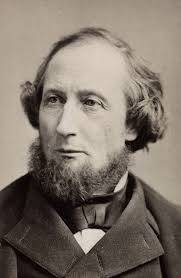
Cyrus West Field
https://www.britannica.com/biography/Cyrus-W-Field
He and his brother, David, an attorney had built twin mansions side by side facing Gramercy Park which was then being developed into a private park for the neighborhood in 1844 by Samuel Ruggles.

Samuel Ruggles, the creator of Gramercy Park
https://en.wikipedia.org/wiki/Samuel_B._Ruggles
Cyrus West Field along with Fredrick Newton Gisborne, a Canadian inventor and electrician had laid out the first undersea cables. Partnering up, they laid the first successful cable line to Europe in 1866 after two other failed tries. Even with his successes, when his wife, Mary died in 1891 and his son’s banking business failed and his partner’s daughter in law was his sister, Grace who took ill and died later that year. Cyrus Field was vacationing in his summer home when he died as well (Wiki & the tour guide).
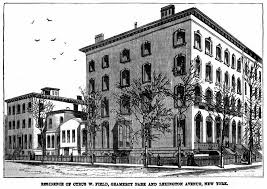
The Field Mansion before it was torn down
http://daytoninmanhattan.blogspot.com/2013/11/the-lost-cyrus-w-field-mansion-gramercy.html
https://en.wikipedia.org/wiki/Cyrus_West_Field
Both his and his brother’s house were purchased by another banker who renovated them into one mansion. His business would later fail and he also was forced into bankruptcy. The houses were part of an ever-changing New York neighborhood and were demolished and replaced by the Italian Renaissance apartment building that sits there today with the plaque neatly presented on the side of the building. A very interesting place for a colorful family history.
After we left the site of the Field Mansion, we toured the sides of Gramercy Park, which was created in 1844 by Samuel Ruggles, who developed the area as an exclusive enclave. The 22-acre site was once a swamp and the farm of James Duane, the son of the Mayor of New York and a direct descendant of Peter Stuyvesant, called ‘Gramercy Farm’. The park was enclosed by a fence in 1833 and the parcels surrounding it were developed in 1840. The park’s landscaping was done by James Virtue and the park was surrounded by 39 lots whose owners had access to the private park. Today only those people residing in the 39 lots surrounding the park can have a key to it and help in the maintenance of the park (Wiki).
As we passed the park which looked a little sparse due to the time of the year with the exception of the pines and the Christmas Tree in the center of the park. Still, you can see the elegance of the park and the constant upkeep of the landscaping. Behind the locked doors, it is almost a secret garden almost waiting to be discovered. Even today, you still need that key to open the door to the park and you have to live in the area to get in.
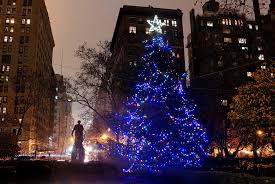
Christmas Tree in Gramercy Park today
https://en.wikipedia.org/wiki/Gramercy_Park
While we were at the park, the tour guide gave us a little history of a Victorian Christmas and the rules and etiquette of the holidays under the rule of Queen Victoria and her marriage to Prince Albert who was from Germany.
When the marriage took place, Prince Albert had brought many of his traditions with him and introduced the Pagan tradition of bringing evergreen trees into the house. Since it was the only tree that was green during the long winter months, the Pagans brought it into the warmth as a sign of life. It was later decorated with sweets and small gifts then got more elaborate with candles and ornaments. Ornaments started to appear in 1853.
The idea of the Christmas card came in 1843 when Henry Cole created the first card with a simple message. By the 1880’s, the Victorians were sending out the cards in great numbers due to the advancement of the postal services, many of them handmade by the children of the house. Decorating the house got more and more elaborate. What had started with a simple tree and garland to decorate the doors and windows became more detailed with decorations.
Gift giving was once relegated to New Year’s Day but as Christmas became the more predominate holiday, gifts were given either Christmas Eve or Christmas Day. Initial gifts were things like small handmade trinkets and sweets and then moved to store bought gifts from the developing department stores that could be placed under the tree.
The Christmas Dinner had its roots in Medieval times but became more elaborate after the Civil War. During the Revolutionary War, Christmas Day meal was a family affair after church services but by the 1880’s as the Industrial Revolution started to change the way we lived, it became the feast we celebrate today.
Roasted meats like goose and duck were some of the things served but later turkey became a favorite for dinner. It became predominate on a middle-class family table because the average turkey could feed a family nicely for dinner. Even Christmas crackers, which were invented by Thomas Smith in 1848 on an idea he saw in Paris on the way bon-bons were wrapped. He perfected them to ‘pop’ when they opened and were then filled with candies and small toys. This became part of the place setting.
Since the holiday was now being based around the family, things like parlor games and Christmas carols became family favorites. Carols had started during Medieval times and had been brought back by the Victorians. The family was the center of the holiday, and a family was only restricted by their budget.
There were also strict rules on visits during the preparation for the holiday. Our guide pointed out that when you visited a home leading up to the holidays, etiquette stated you stayed for about ten minutes and you only partook in the food that was laid out, such as a plate of Christmas cookies and you did not linger. The host had lots to do to prepare for the holiday and she did not want you stay and take up her time.
As we rounded the corner and the tour guide discussed the attributes of the park, he also talked about the history of the architecture that surrounds it. Many structures have a long and very interesting history.
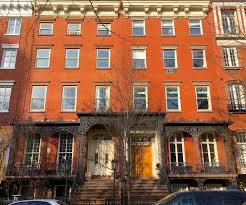
4 Gramercy Park West
https://streeteasy.com/building/4-gramercy-park-new_york/1
At 4 Gramercy Park West is the James Harper House, which almost resembles something you would see in New Orleans with its decorative iron work and graceful porches. The homes were built in 1846 for the James Harper, the Mayor of New York and one of the founders of Harper-Collins Publishing. The house was a Greek Revival design with an iron lace terrace with a mirror image of the home next to it with the exception of the lamps outside the house.
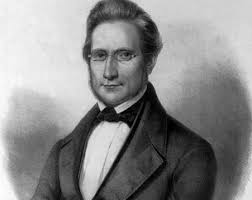
James Harper, Mayor and Publisher
https://en.wikipedia.org/wiki/James_Harper_(publisher)
History has said that the lanterns in front of the home are a throwback to the Dutch era when lantern bearers accustomed to escort the Burgomaster home with the proper dignity from the city tavern or another place of entertainment. The Dutch custom of placing special lamps at the mayor’s door was an aid to finding his house at night but by Harper’s Day, it was just ceremonial. The customer ended with the establishment of Gracie Mansion as the Mayor’s residence (Ephemeral New York).
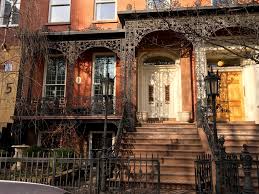
3 & 4 Gramercy Park
http://daytoninmanhattan.blogspot.com/2013/12/nos-3-and-4-gramercy-park-west.html
https://streeteasy.com/building/4-gramercy-park-manhattan/1
Harper died in 1869 and the house stayed in the family until 1923. It was known also for being the rumored home townhouse for the book “Stuart Little” and again achieved fame for being on the cover of Bob Dylan’s 1965 album cover for ‘Highway 61 Revisited’ (Ephemeral New York & the tour guide).
From the Harper House, we visited the Samuel Tildon House at 15& 16 Gramercy Park South around the corner from the Harper House. This historic townhouse was built in 1845 and the home of former New York Governor Samuel J. Tilden who was a fierce opponent of the Tweed Ring and the losing Presidential candidate in the 1876 election. He lived in the house until his death in 1886 (Wiki & tour guide).
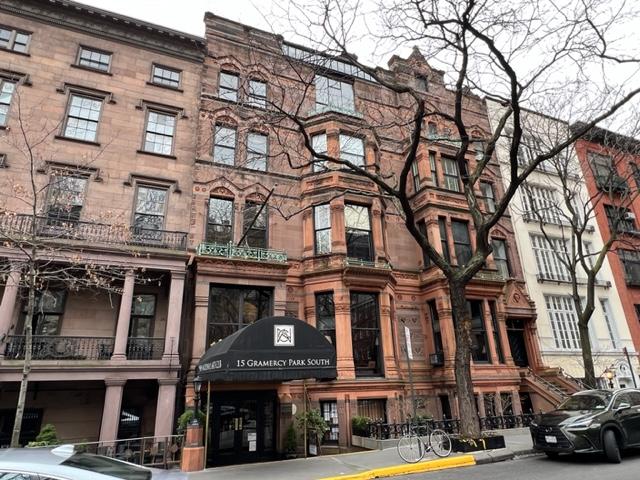
The Tilden House today is a private club
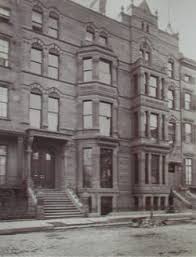
The Samuel Tilden House
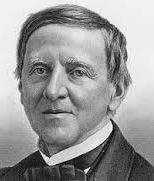
Samuel Tilden Politician
https://www.britannica.com/biography/Samuel-J-Tilden
The house was combined and redesigned by Calvert Vaux with the row house next door to make the building it is today. The brownstone was considered the height of Victorian Gothic in residential architecture with Italian Renaissance style elements. Since 1906, it now serves at the National Arts Club (Wiki & tour guide).
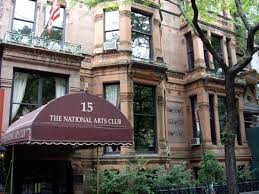
National Arts Club at 15 Gramercy Park South
https://www.nationalartsclub.org/
The home at 16 Gramercy Park South, now the home of the Players Club has an interesting past as well. The home was bought by Edwin Booth, one of the great Shakespearean actors of the 19th Century and one of the founders of The Players Club. He was the brother of John Wilkes Booth, the assassin of Abraham Lincoln. He turned over the deed to the house in 1888 to the club (Wiki & tour guide).
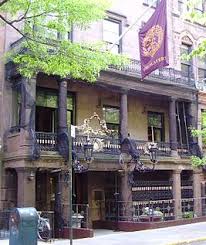
The Players Club which was owned by Edwin Booth
From the square of scandals and shame we moved to look inside the park where a statue of Edwin Booth stands. It was an interesting twist of events that he landed in New York City. The whole area was designated as the Gramercy Park Historical District in 1966 (Wiki & the tour guide).
Our next place to visit was the famous Pete’s Tavern at Irving Place at 129 East 18th Street. This famous bar/restaurant has been around since 1864 and has been a major watering hall for the neighborhood. The building was originally known as the Portman Hotel and was built in 1829. It was known as a ‘grocery & grog” store and may have been serving alcohol since 1852 (Wiki).
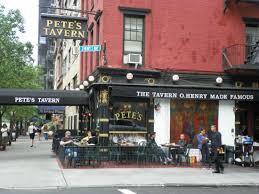
Pete’s Tavern is now an Italian restaurant
Welcome to Pete’s Tavern….the Tavern O. Henry made famous!
The writer O. Henry lived down the block at 55 Irving Place from 1903 to 1907 when the place was called Healy’s after Tom and John Healy, who bought the restaurant in 1899. The famous writer included the name of the bar in a short story entitled “The Lost Blend” under the name “Kenealy’s”. It has been rumored that he wrote the well-known story “The Gift of the Magi” in the second booth from the front but it cannot be proved (Wiki & the tour guide).
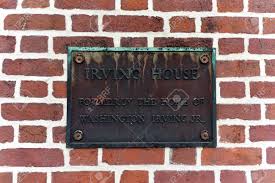
The Irving House
Around the corner from Pete’s Tavern is 11 Commerce Street, the Irving House, the former home of Washington Irving’s sister. The Federalist style home was built in 1826 and was rumored to be where he wrote part of the book “The Legend of Sleepy Hollow”. No one was too sure where Washington Irving Jr. came from because Washington Irving did not have any children.
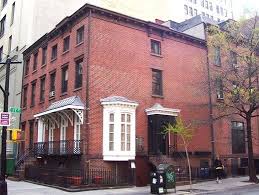
The Irving House at 11 Commerce Street
https://www.atlasobscura.com/places/the-irving-house-new-york-new-york

Washington Irving Author
https://www.britannica.com/biography/Washington-Irving
We left the Gramercy Park District which is slowly changing on the fringes of the Historic District from residential to modern hotels and apartments refigured into the older buildings of the neighborhood to the very modern and updated and hip Union Square Park.
Union Square Park was once the cross-roads from the old commercial part of Manhattan to the residential part of the island. When Manhattan was surveyed by John Randel for the Commissioner’ Plan of 1811 to create the grid of the island, Broadway angled away from the Bowery that would have been awkward to build on and it was decided to create a square at the union of the two streets. Samuel Ruggles, who had created Gramercy Park renamed the are ‘Union Square’ from its former name, ‘Union Place’. It was Ruggles who developed the area with streets and plantings at the park (Wiki & the tour guide).
At first the area was a fashionable residential area surrounded by brownstones and mansions but after the Civil War, the area gave way to a commercial shopping district that included Tiffany & Company and FAO Schwarz Toy Store. The area is now home to many upscale merchants and restaurants once again. It also has one of the biggest Farmer’s Markets in the City.
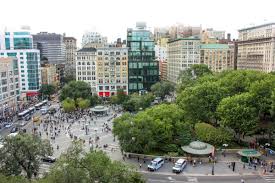
Union Square today facing the once fashionable shopping district
https://www.unionsquarenyc.org/
From Union Square, our group walked to Sixth Avenue down West 17th Street to the start of the Ladies Mile Historic Shopping District. Today the area is still going through changes from discount superstores to advertising and communications companies but between the Civil War and World War I, the district was home to some of the most famous department and specialty stores of the time, places of worship and performance venues like the Academy of Music and Steinway Hall (Wiki & the tour guide). It is here where Victorian Christmas roots began.
We started the tour on West 17th Street and walked our way up Sixth Avenue while admiring the old department store buildings. One point that the tour guide wanted us to all note was the big windows on the second and sometimes third floor of the buildings. This was done when the old ‘Sixth Avenue El’ subway line used to travel down the avenue before the war so that people could see the clothes and fashions from the elevated subway cars. We walked up Sixth Avenue, and we noted all the stores we passed and a little on the history of each store.
The old B. Altman & Company building located at 625 Sixth Avenue between West 18th and 19th Streets was once a luxury department store that catered to the strictly ‘carriage trade’ clientele of the time. It had been founded in 1865 by the Altman family on the lower East Side and progressed uptown to this location in 1877. It was originally designed by David and John Jardine, a New York architectural firm.
The store had been known for couture merchandise and fine furniture. As the clientele changed and moved uptown after World War I, the company moved the new store to Fifth Avenue and East 34th Street in 1906. The company went bankrupt in 1990 (Wiki, History of Department Stores & the tour guide).
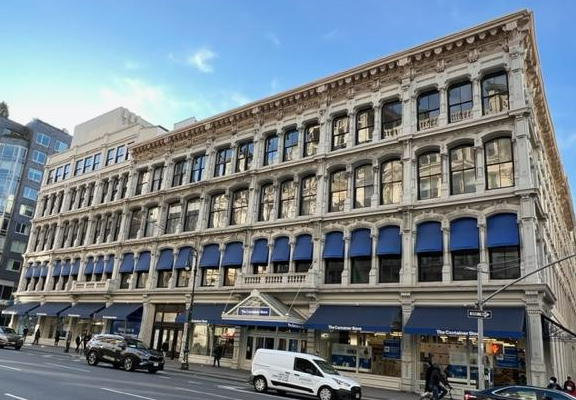
B. Altman & Company store at 625 Sixth Avenue & West 18th Street
https://en.wikipedia.org/wiki/B._Altman_and_Company
Our next stop was at the old Siegel-Cooper Company Department store at 620 Sixth Avenue at 18th Street. The company was founded in 1887 by Henry Siegel, Frank Cooper and Isaac Keim in Chicago and opened their store on State Street.
Their second store opened in New York City in 1896 at 620 Sixth Avenue between West 18th and West 19th Streets. The store used innovative steel-framing, the first department store in New York to use this construction, to create the world’s largest store at the time (to be surpassed by Macy’s Herald Square). The offered a wide variety of dry-goods and shops including a art gallery, conservatory selling plants, a photo studio and a 350-seat restaurant. The store was designed by the firm of DeLemos & Cordes in the Beaux-Arts style (Wiki & the tour guide).
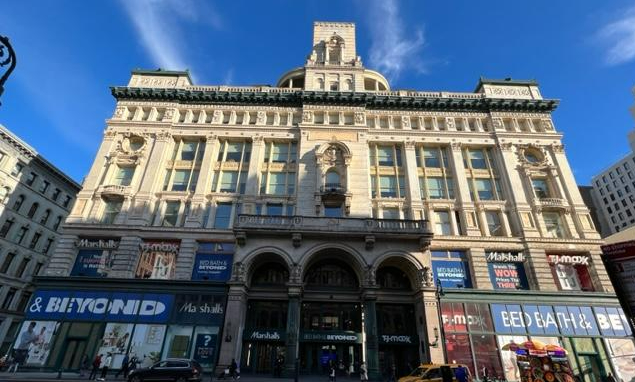
The Siegel-Cooper Company store at 620 Sixth Avenue
http://wikimapia.org/16891212/Simpson-Crawford-Simpson-Building
http://daytoninmanhattan.blogspot.com/2010/08/big-store-1896-siegel-cooper-department.html
The main floor featured a copy of David Chester French’s statue, The Republic inside a marble enclosed fountain on the first floor which the phase “Meet me at the Fountain” became the store slogan (Wiki & the tour guide).
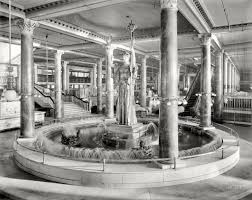
The fountain that was at Siegel-Cooper
Yet by 1902, Henry Siegel sold the store, and the company went bankrupt in 1915 and the store closed in 1917 and became a military hospital during World War I. Today the store is home to Marshall’s and TJ Maxx. Its ornate outside is really hidden now.
We next moved on to the Simpson-Crawford Department Store at 641 Sixth Avenue between West 19th and 20th Streets, which once catered to the wealthy elite of Manhattan and beyond. The store was established in 1878 by Richard Meares and William Crawford as Richard Meares & Company. Meares left the firm a year later and William Crawford then partnered with Thomas and James Simpson to create Simpson, Crawford and Simpson. When Thomas Simpson died in 1885, the store became known as Simpson-Crawford (Daytonian in Manhattan).
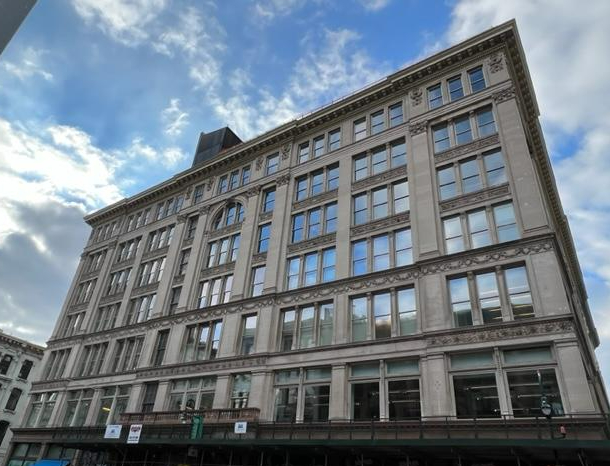
Simpson-Crawford Store today at Sixth Avenue between West 19th and 20th Streets
http://wikimapia.org/16891212/Simpson-Crawford-Simpson-Building
When James Simpson died in 1894, William Crawford became the sole owner and in 1899 with the rise of the great stores on Sixth Avenue, Crawford designed a new store of marble designed by William H. Hume & Son. The exterior of the store shined with polished marble and granite (Daytonian in Manhattan & the tour guide).
The store had many innovations at the time. It had the first escalator in the city, the first display windows with mannequins and large display windows that had to be created for the store. The store was stocked with the finest imported clothes, furs and laces and on the top floor was a restaurant that catered to 1200 guests (Daytonian in Manhattan & the tour guide).
Before the store opened, William Crawford retired and sold the store to Henry Siegel across the street who kept the tradition of the store going. When Siegel-Cooper Company collapsed in 1914, Simpson-Crawford was kept closed for three weeks and then reopened. Both stores closed one year later, and the store was converted to mail order warehouse. Today it holds various stores (Daytonian in Manhattan).
Our next stop was in front of Hugh O’Neill’s Dry Goods Store at 655 Sixth Avenue between West 20th and 21st Streets. It was built by the firm of Mortimer C. Merritt in the neo-Greco style who built the four stages of the building between 1887-1890 (Wiki & the tour guide).
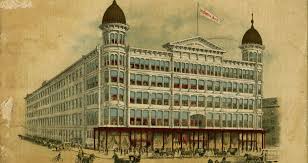
The Hugh O’Neill Store when it opened in 1890
https://en.wikipedia.org/wiki/O%27Neill_Building
Hugh O’Neill had started a small dry goods business right after the Civil War in 1865 with a small store around Union Square. In 1870, he decided to build a trade on the middle market customer and offered discounts on goods. The four floors of merchandise contained laces, ribbons, clocks and on the upper floors women’s and children’s clothing (Wiki).
When O’Neill died in 1902, the shopping area had just begun its decline and in 1906 it merged with Adams Dry Goods up the block. A year later they both went out of business as the area gave way to manufacturing. The building today has been converted into condos.

The Hugh O’Neill store today
Our last store that we looked at and discussed was the former Adams Dry Goods Store at 675 Sixth Avenue between West 21st and 22nd Street.
Samuel Adams, a merchant who had been selling upscale clothing and furnishing to customers in the area decided to open a store on Sixth Avenue. He used the architectural firm of DeLemos & Cordes, who had designed the Seigel-Cooper Department Store and the six-story building opened in 1902. The store was the first in New York City to use the new Pneumatic tubes to transport money and messages throughout the store (Wiki).

Adam’s Dry Goods Store when it opened in 1902
http://daytoninmanhattan.blogspot.com/2010/10/1900-adams-co-building-675-sixth-avenue.html
http://wikimapia.org/16882716/Adams-Dry-Goods-Store-Building
The problem with the store was its location. He built the store at the very edge of the neighborhood as the business changed. As the shopping area started to decline in the early 1900’s, Adams sold the store to Hugh O’Neill Dry Goods Store and they merged the two companies together, converting three floors of the Adams Dry Goods store to furniture. This concept was not popular as well and the businesses failed, and the store closed in 1913 (Wiki & the tour guide).
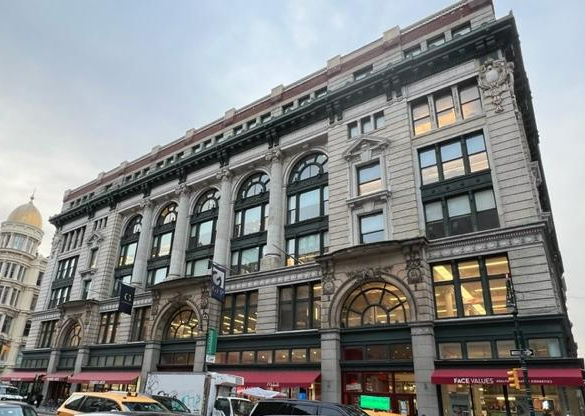
Adams Dry Goods Store today at Sixth Avenue between West 21st and 22nd Streets
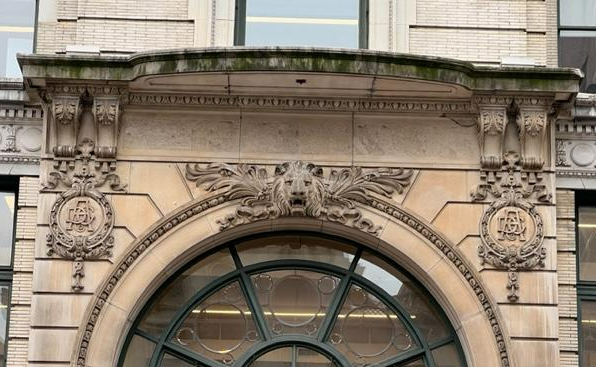
The beautiful details of Adams Dry Goods can still be seen

The store has gone through a manufacturing stage and in the 80’s became part of the change to large box retailing. The building now houses eBay and several stores including Trader Joe’s and Michael’s. As we could see on the tour, the old department stores are finding new life in retailing.
Between West 22nd and West 23rd Streets located between the old Adams Dry Goods and next to the former Macy’s store was Ehrich Brothers Department Store at 701 Broadway. The building was constructed in 1889 by architect William Schickel & Company with additions by Buchman & Deisler and Buchman & Fox in 1889 (Wiki).
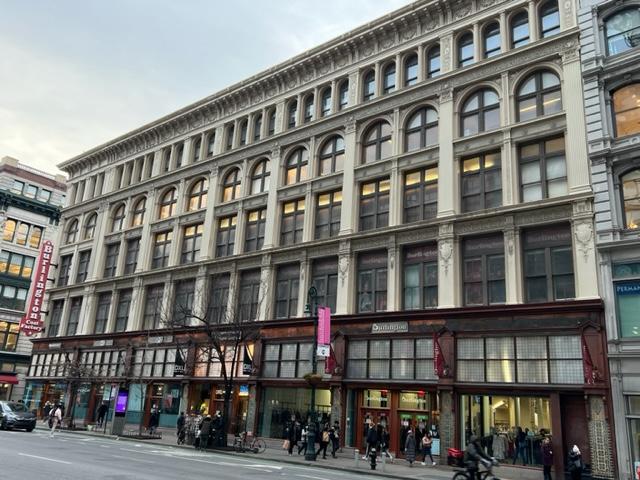
Ehrich Brothers Department Store building at 701 Sixth Avenue (Wiki)
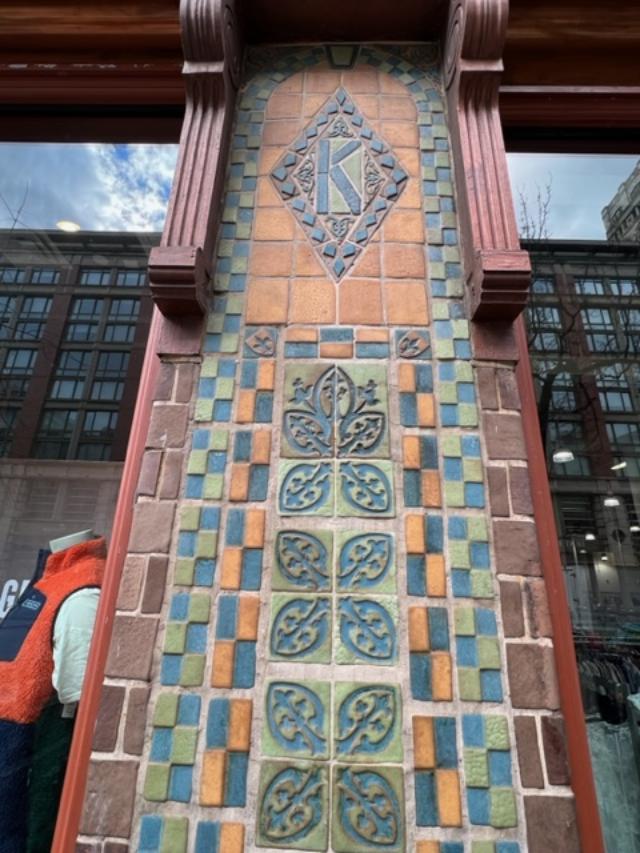
The terra cotta ‘K’ of the J. L. Kesner Department store still on the building
Another addition was added by Taylor & Levi in 1911 when the store was leased to J.L. Kesner. They added the terra cotta “K”s that can still be seen from the top of the storefront. The store folded in 1913 and then was used for manufacturing and offices as the shopping district moved to 34th Street and the Fifth Avenue area (Wiki).
The last part of our tour discussed one of the most famous Christmas poems, “A Visit from St. Nicolas” or known as “Twas the Night Before Christmas”, which was one of the first mentioning’s of Santa Claus in a modern form, written in 1822 and published in 1823 anonymously. Some saw the poem as a social satire on the ‘Victorianization’ of Christmas (Wiki & the tour guide). Our tour guide said you really have to read into the poem to see what it is really saying about the times that it was written in. He noted really read the line “Had just settled our brains for a long winter’s nap” as the stress of the holidays and child rearing was even back then.
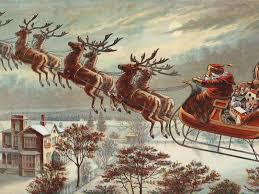
“A visit from St. Nicholas”
https://poets.org/poem/visit-st-nicholas
It was in 1837 that poet Clement Clark Moore claimed to be the author. Even today there is a controversy of who really wrote the poem, Clement Clark Moore or Major Henry James Livingston Jr. This discussion is still being debated today (Wiki).
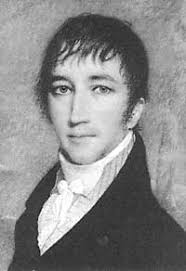
Clement Clarke Moore poet
https://www.poetryfoundation.org/poets/clement-clarke-moore
https://www.poetryfoundation.org/poems/43171/a-visit-from-st-nicholas

Henry James Livingston Jr. Writer
https://www.poetryfoundation.org/poets/henry-livingston
How the poem mixed well into the tour is that Clement Moore’s family owned an estate here on the area on West 23rd Street between Hudson River and Eighth Avenue from West 24th Street to West 19th Street. His home was at 348 West 23rd Street. He developed the area after donating a large portion of the estate to his church and created a residential neighborhood that still stands today.
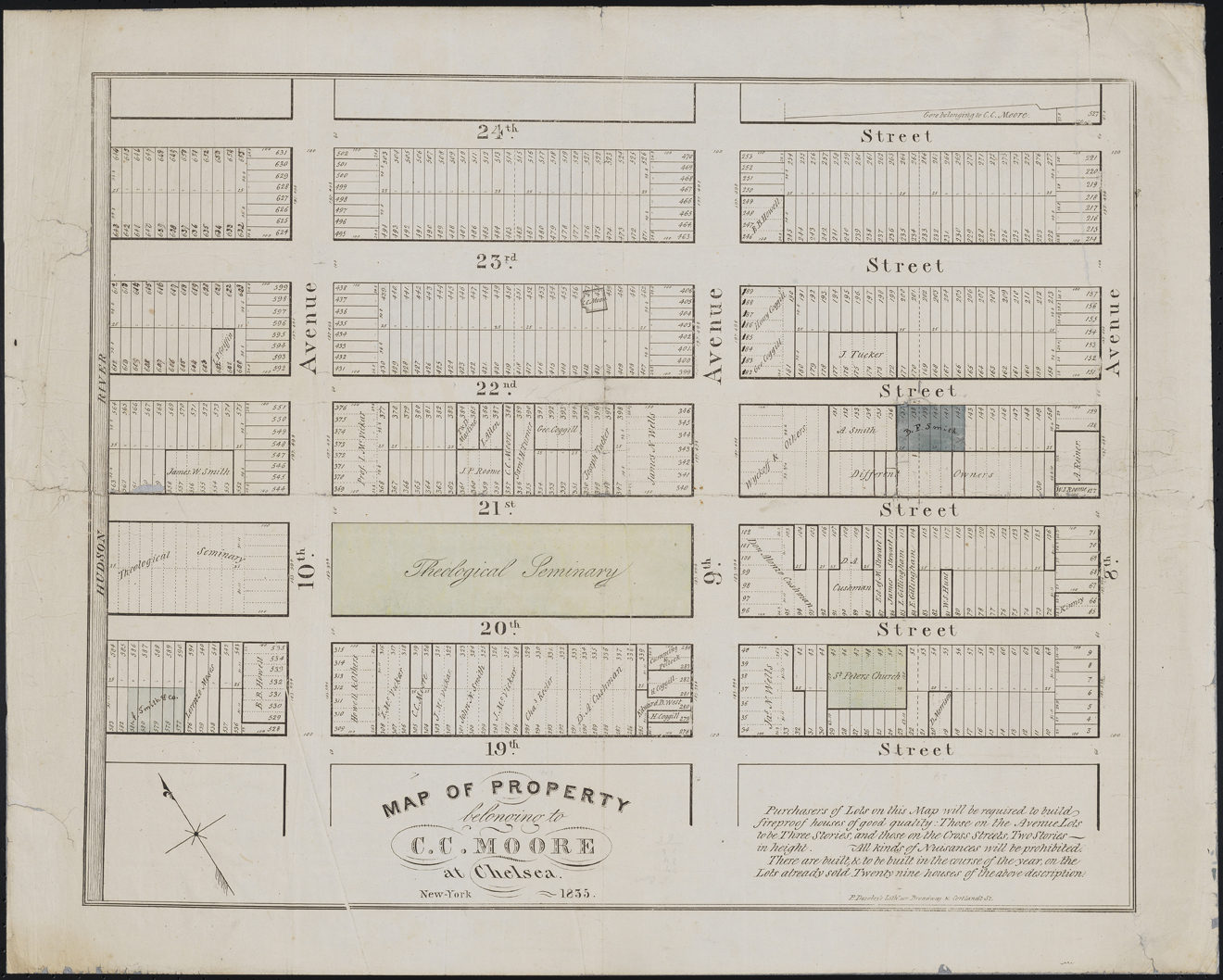
The Clement Clarke Moore estate when he sold it into real estate parcels
https://thegreatestgrid.mcny.org/greatest-grid/selling-lots/87
http://daytoninmanhattan.blogspot.com/2017/12/the-lost-clement-c-moore-chelsea-house.html
I walked the entire neighborhood after we said our goodbyes on Ninth Avenue by the subway and discovered an ever-gentrifying neighborhood of brownstones and small mansions. The one home that stood out amongst the brownstones was the James Wells Mansion at 400-412 West 27th Street.
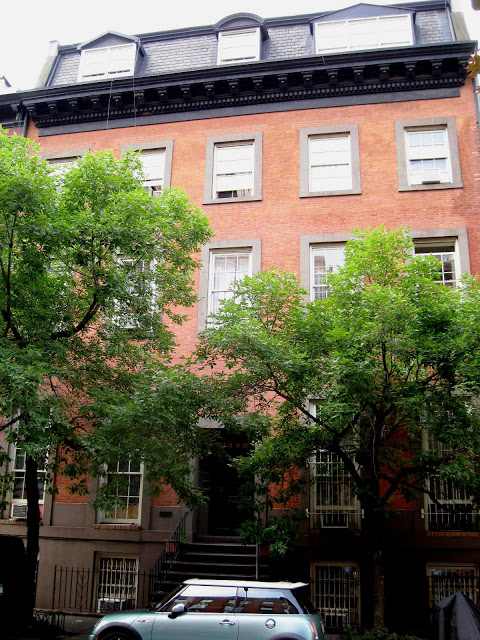
The James Wells Mansion in Chelsea one of the most beautiful homes on the block
https://www.hmdb.org/m.asp?m=127242
http://daytoninmanhattan.blogspot.com/2011/11/james-wells-house-at-no-162-9th-avenue.html
James N. Wells was a real estate broker and built the house in 1835 when Clement Clarke Moore developed this part of his estate. He built the grand house for his family. Sometime in 1866 after the Civil War, the house was renovated, and a mansard roof was added to the house. It must have not stayed in the family too long after this as it was turned into a home for the aged in 1867 (Wiki). Today it has been restored by its owners to its grand glory.
The last part of the tour I visited the only spot that still carries the name of the family to know that the estate was located here, and it was the Clement Moore Park at West 23rd to 22nd Streets on Tenth Avenue. The park was initiated by the West 400 Block Association to turn a neglected lot into a park and in 1965 it was opened to the public. When I visited the park that afternoon and others to complete the walk of the neighborhood, the park was closed for renovations.
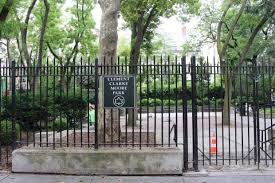
Clement Moore Park before the renovation
https://www.nycgovparks.org/parks/clement-clarke-moore-park
This is where I ended the tour that day. I walked this part of West 23rd Street from Sixth Avenue to Tenth Avenue on my own to see the development of the estate and how the gentrification of Chelsea was progressing. Let me put it this way, the Clement Clarke Moore brownstone was on the market in 2016 for 8.7 million dollars. I wonder how he would feel about that today.
Check out my Christmas blogs this year (2018) and my busy holiday season that stretched from the Hudson River Valley in New York State to Rehoboth Beach, Delaware. I swear my feet never touched the ground the whole holiday season.
Merry Christmas and a Happy New Year everyone!
I want to add these two new Christmas songs by the late jazz artist Al Jarreau and current up and coming artist Lindsey Webster for you all to enjoy. They got me through my Christmas Holiday season:
Christmas Morning by Al Jarreau:
It’s Gonna Snow on Christmas by Lindsey Webster:
Rather than display each property we visited, I attached the link for further reading.
Again everyone has a very Merry Christmas and a Happy New Year!
